Hue - Pagoda of the Celestial Lady and Thich Quang Duc Self-Immolation
One day, when I was reading the treasures of Vietnamese tales of Nguyen Dong Chi, I have encountered the story of Thien Mu Pagoda. ( Pagoda of the Celestial Lady)
1 - The Legends of the Pagoda
It is said that when Lord Nguyen Hoang was looking for land to determine the capital of Vietnam, to the hillside area beside the Perfume River, he met a white-haired elderly woman. The Lord asked the old woman, when the old lady gave him a scoop and told him:
"You took this scent down the river, to where the scent burned, where it was the place you are in need ".
Nguyen Hoang believed in the old lady; Nguyen Hoang Lord has swept Perfume stream to the imperial city of Hue now compressed incense burns. God stopped there, opened the land, built the Nguyen dynasty existed over 200 years 13 successive dynasties. Thanks to the old lady who pointed to Nguyen Hoang, Lord Nguyen Hoang built a temple at the place where he met the old man to worship and named Thien Mu Pagoda.
If you translate Thien Mu in English, it means that she- the lady was sent by God. In fact, as far as I know, there exists a Cham temple - a legendary people who lived in Hue, however, according to the decision of Lord Nguyen Hoang, the new temple was officially built.
Moreover, I also know that the construction of the temple of Lord Nguyen Hoang is also associated with another legend. Legend has its origin around the idea that Ha Khe is a sacred hill. In the Tang Dynasty there was a general named Cao Bien who traveled all over the mountains, rivers and oceans to see where the sacred route was (the route for being a king) so he would have destroyed it. Cao Bien saw on Ha Khe the sacred hill and digged the foothills to the way, so that the sacred hill cannot be settled. That night there was a beautiful woman who looked young but her hair was grey, her red dress was at the bottom of the hill, and she spoke out loudly:
"Life after the national level to build a mountain circuit to make the circuit for the tide, should set up Buddhist temple, request the spirit returned to this mountain to help the country, there is nothing to worry about. "
The woman finished her speech and then she just disappeared. Since then, the mound is being called Thien Mu Mountain (the lady sent by God Mountain). Anyway, visiting Thien Mu Pagoda, I also feel why this temple is called the most beautiful temple in Vietnam; the pagoda is located on a hill in the old Ha Khe commune overlooking the Huong River, As if the dragon head turned around, about 5 km west of Hue City.
I can imagine that this used to be a desert hill in An Ninh village, Huong Tra district, now Huong Long ward, Hue city. Under the eyes of our ancetors, the location of Thien Mu Pagoda is significantly rare but in harmony with the nature. The pagoda is located on a hill with many lush green trees, behind the long mound stretches, in front of the Perfume River, as silk ribs hugging the foothills create harmony between romantic architecture and nature. The temple has a large campus of nearly 4 hectares, surrounded by a large perimeter brick wall, in front of the family tower, behind the temple; all of them look solemn and fanciful.

Phuoc Duyen Tower - the tallest pagoda tower in Hue
My family visited the Pagoda during the trip to Hue! That day, our family was lucky to visit Phuoc Duyen Tower which is a famous symbol associated with Thien Mu Pagoda.
The 21 meters high tower, consisting of seven floors, was built in front of the temple. Each floor has a statue of Buddha. Inside, there is a spiral staircase leading up to the top floor, where there was a golden Buddha statue. In front of the tower is the Huong Nguyen Temple. Thien Mu Pagoda now has two bells. A bell was erected in 1710 in an octagonal house on the right side of Phuoc Duyen Tower, on which there is Lord Nguyen Phuc Chu's inscription. This bell is now only set as a measure of the temple, it is not for ringing.
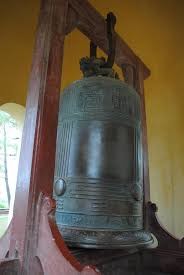
When the bell was in charge of keeping the rhythm of the "Thien Mu Bell" it was the 14th year of Gia Long Emperor. I suddenly remembered a folk sentence!
The wind blows the leaves
Thien Mu Bell rings, Tho Xuong chicken crows
Moreover, I also know that Thien Mu Pagoda is also associated with a tragic love story, a traumatic area that is still handed down, Hue people often take it to explain why the couple They rarely come together to pray together. I travel alone in Hue, I do not visit Thien Mu Pagoda with my girlfriend for the same reason.
2 -Thien Mu Pagoda’s tragic love story!
Legend says that, in the Nguyen Dynasty, there was a loving couple. The girl was from a noble family full of honor, mature, gentle, full of sense and virtue, virgin. The boy was orphaned and poor. So their affair was severely opposed by the girl's family. For 5 years, they just sneak up dating each other, trying to convince the girlfriend to work for the coast but not. They brought each other to Thien Mu Pagoda praying heaven to bless each other to live together for a lifetime. However, during those five years, the girl's house not only changed mind, but also forced her to get married with a young mandarin in the court. Being squeezed to the end, the boys and girls have been dating each other for 6 years. They decided to commit suicide together on the banks of the Perfume River. They hoped that when they died together, they would have lived forever together.
Strangely, the water of the Perfume River had just drowned the boy to the death but the girl drifted to shore and was rescued by fishermen. Since then, the girl was confined to her family. She always tried to commit suicide to follow him but failed.
As time goes by, the pain of losing the lover gradually settles, the girl follows the arrangement of the family, married the one-to-one with a rich man and lived a comfortable, full life. The unsatisfied soul guy lying on the bottom of the Perfume River is waiting forever but he could not see the lover, hate for his destiny, and "entered" Thien Mu Pagoda "podium" for the couple to the coast of the coast was dispersed his curse. Those who are single, come here sincerely vow, will definitely meet their people in the dream. But there are people who love each other, go to the temple together, they will soon get apart.
By the way, for me, it was such a normal motif tragic love story – however as many people believe, I would not visit Thien Mu pagoda with my girlfriend. I love her and I do not want to lose her.
3- Let’s come back to my trip!
We continued going inside as we meet the Dai Hung Grand Temple.
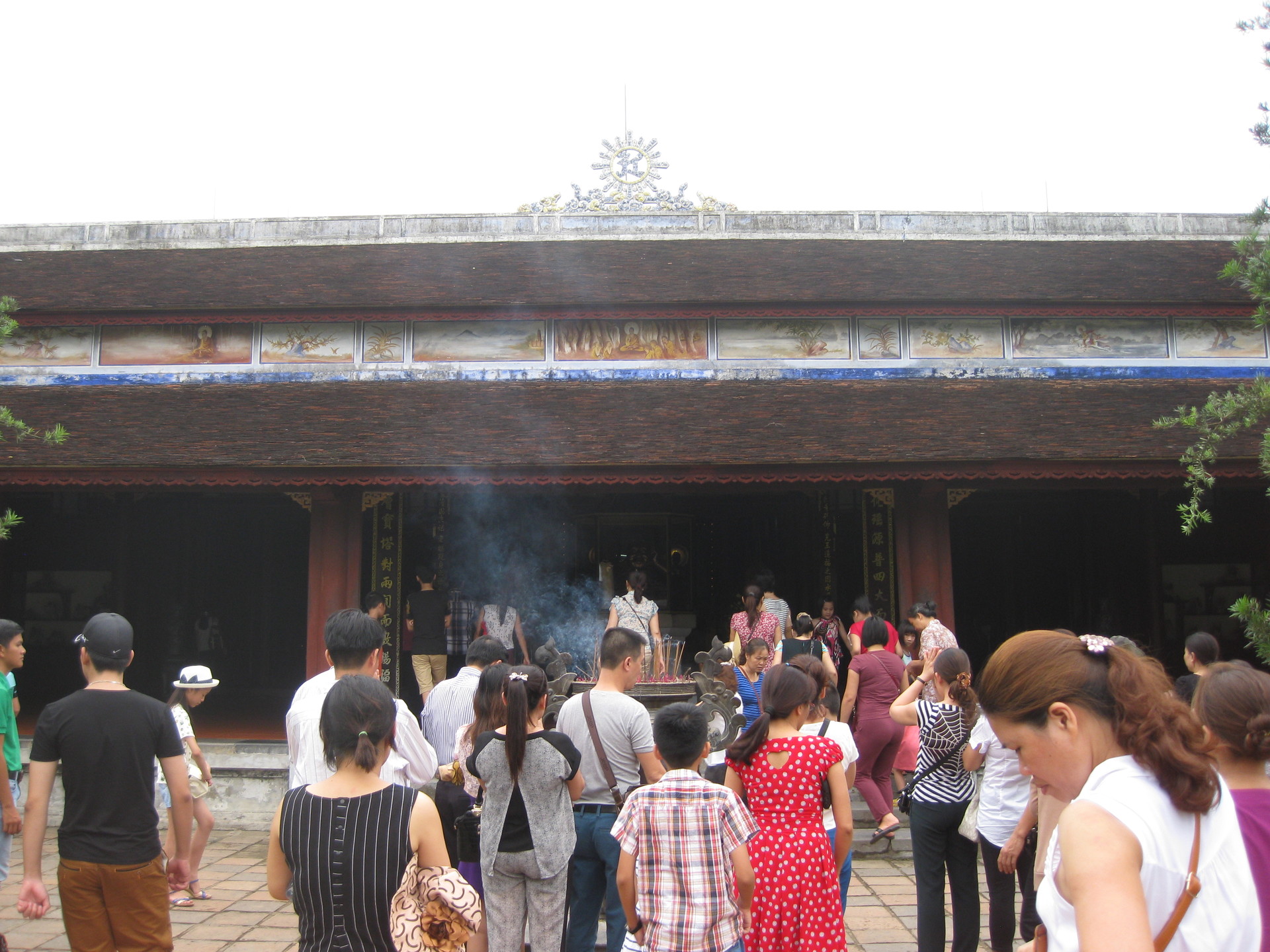
Dai Hung grand temple inside the Pagoda of Thien Mu
Dai Hung temple is the main temple in the complex, also an architectural magnificient masterpiece. Suddenly I saw the columns of the Dai Hung temple are made of cement, the material of the 20th century.
I immediately asked our tour guide. Then, our private tour guide told methat in the past several times remedied by typhoons they have poured cement and covered outside a pseudo-paint.
Moreover, in addition to the bronze statues of Buddha, there is also a large bronze statue, and the engravings are engraved by a Quang Dinh ruler Tran Dinh Grace rented in 1677 to worship the temple. In addition, there is a wooden lacquered gold plate by the hand of Lord Nguyen Phuc Chu title.
Next I looked to the left, then I saw Huong Nguyen which is one of the architectural wooden architecture, very special, currently only reserve the ribs. Dinh Huong Nguyen built in front of Phuoc Duyen tower.
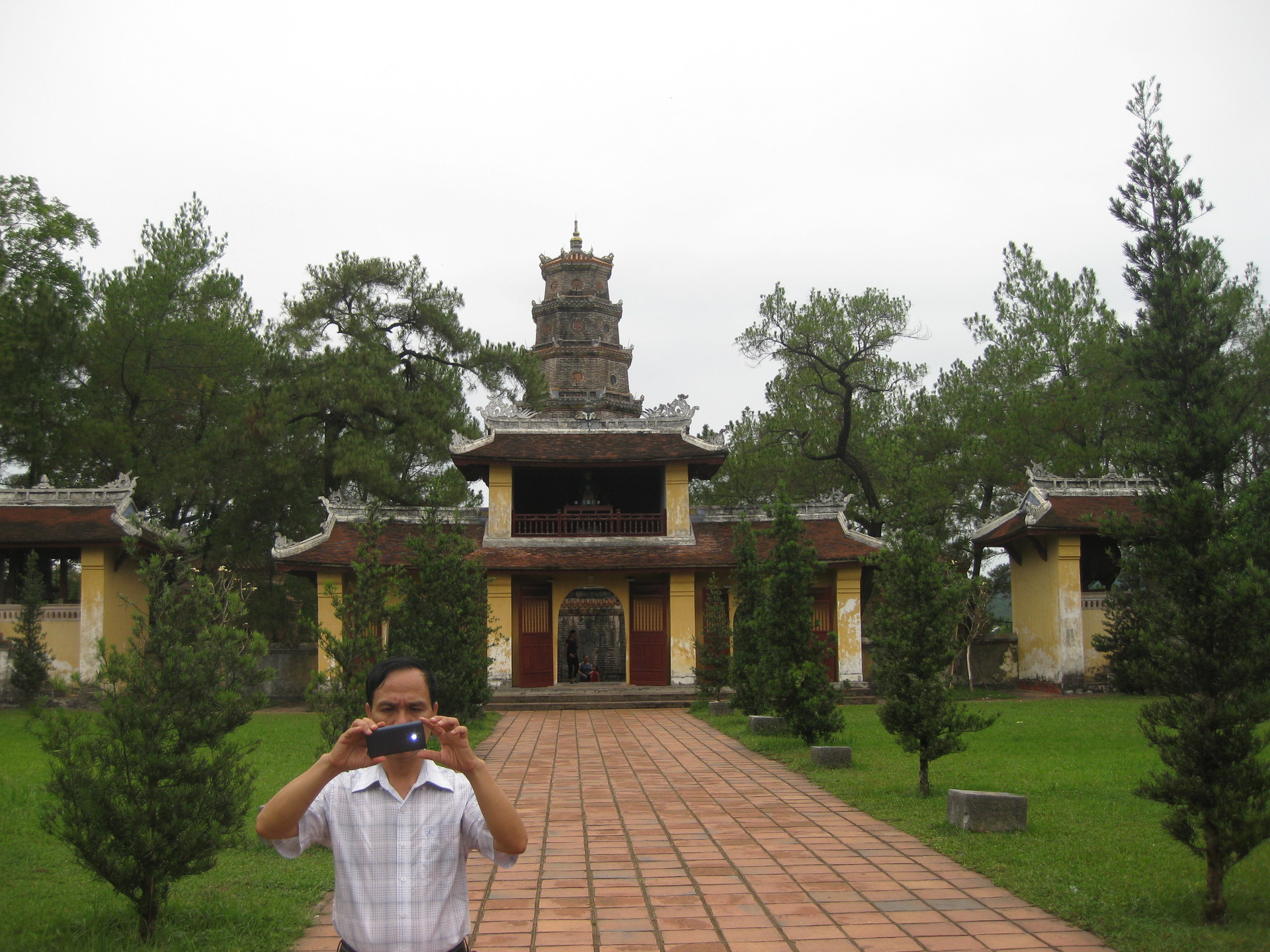
As said in the information board, in the storm of the year of the dragon (1904), the entire construction collapsed.
I was very sorry for this but Hue capital was in the central of Vietnam just 50 km from the sea, it had to receive many tropical storms during the year. That is the reason why the old construction was brought back to reconstructed in the back of the pagoda to worship the Tibetan Buddhism. This is a prototype of a unique quadrangle of 150 years ago. Standing up in the house looking up, I saw the bizarre figure was cleverly structured in the roof.
Anyway, one of the things I like the most at Thien Mu Pagoda is a flower garden that is planted daily in the center of the shed. At that point, the rock of the Vietnamese opera teacher Dao Tan was placed near the car - a relic of the monk Thich Quang Duc left after setting fire to self-immolation opposed the policy of suppression of Buddhism by President Ngo Dinh Diem regime in 1963.
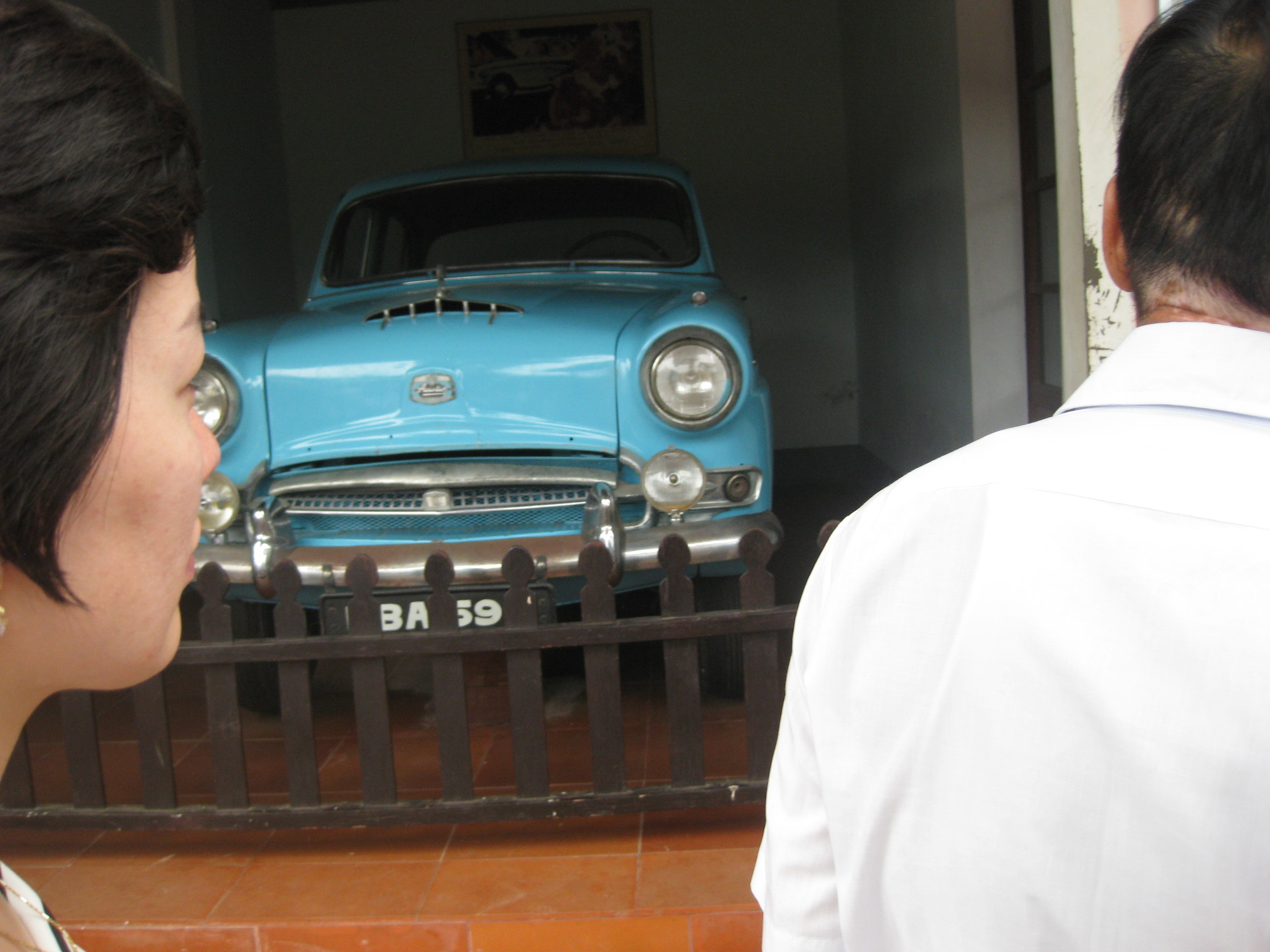
The car usde by Thich Quang Duc to get him into Sai Gon - to burn himself. The event is famous worldwide known as Thick Quang Duc self-immolation.
4- Thich Quang Duc self- immolation
Thich Quang Duc was a famous monk in not just Vietnam but also in the whole world in the 1960s as he was kind of the first name to set fire to himself to show his opposition to the political issue of religion during Vietnam War.
I do not know whether you know him or not but the video of his firing body or the picture of his firing body has been used in many media sources, even in musical video of Linkin Park
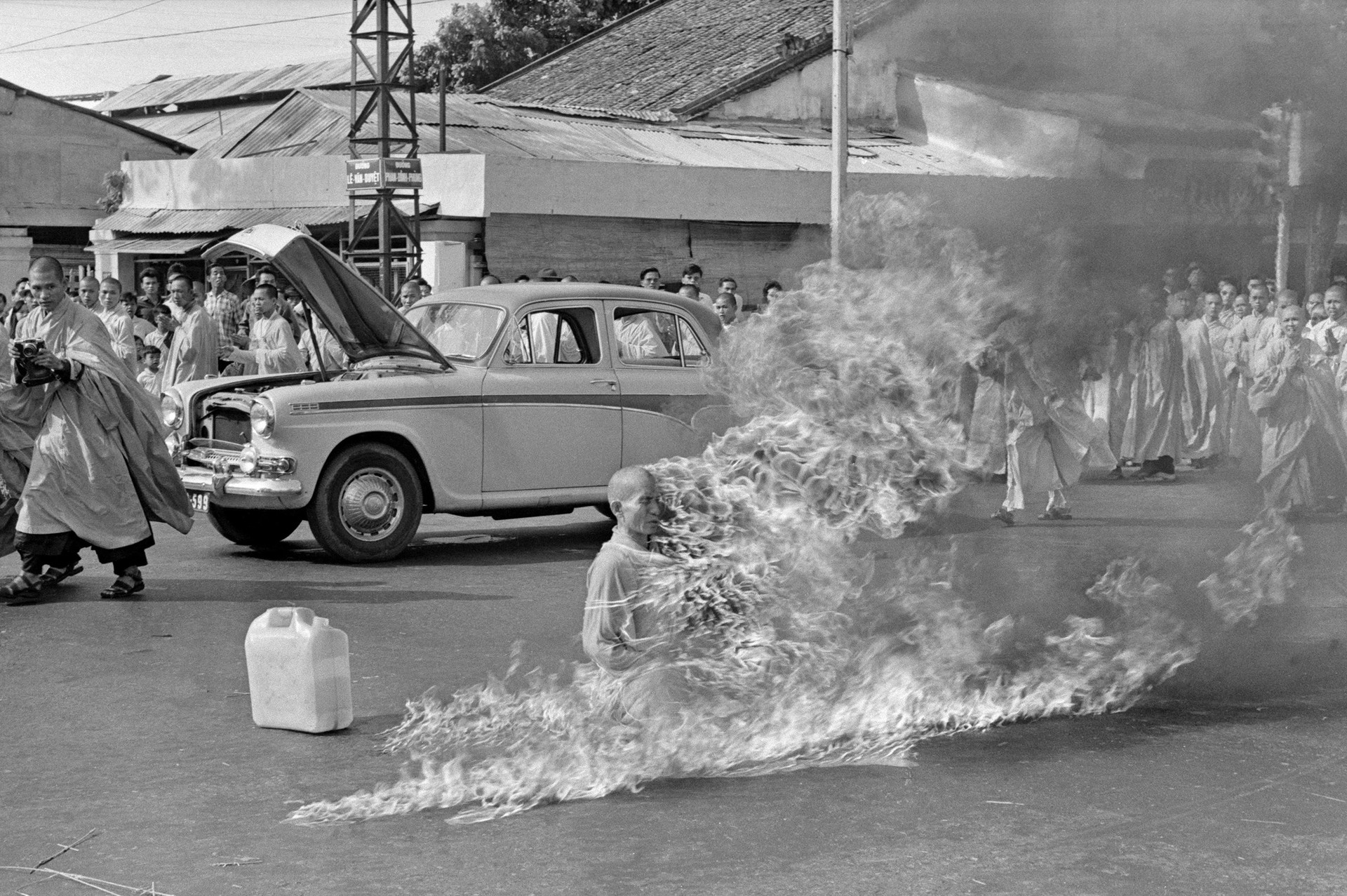
Photo by Journalist Malcolm Browne. The picture was granted with Pulitzer Prize in 1964
Although I was not born that time, however, this is one of the historical lessons that we have to learn in school. Buddhism, as I remember correctly, has existed for more than two thousand years in Vietnam, which is always accepted by the majority of Vietnamese. However, with my country being colonized by the French colonialists, they sought all kinds of ways to encourage the Vietnamese to join the Catholic Church, in addition to a puppet government set up by the USA by Ngo Dinh Diem - a leading pastor has many policies to limit Buddhism. I find it unacceptable, as a result, that Vietnam has never encountered such serious threats and challenges as it did in the nearly forty years of the twentieth century. The point where Buddhism is affected by the three major crises.
First of all, I will mention that the internal force of Buddhism has been exhausted after nearly 100 years by the "task of opening up" of the French colonialists to make Vietnam become more Catholic so Buddhism was forced to leave out of the role of the country's cultural heritage.
Second, during the anti-French in Vietnam, many Buddhist monks and nuns accompanied the people in the anti-foreign invasion, sacrificing their intellectual, physical and material resources in all three regions of the country.
Third, after the country was split in 1954, while Buddhism in the North was almost completely crippled by the consequences of the war, in the South, in the resurrection effort, Buddhism was again faced with nearly a decade of systematic suppression, systematic extermination of the Ngo Dinh Diem government.
The Ngo Dinh Diem administration, with the ambitious "patriarch" of the patriarchal "fatherly patron saint", was a tool of inheritance and persistence, the culture of French foreign policy, nearly 600 years around the world.
Therefore, it is easy to see that Vietnamese Buddhism became the first, continuous and aggressive target of the eight years of Ngo Dinh Diem's regime, a regime whose political duty had made them no other choice, no other way than to destroy Buddhism. So during that period, Buddhism was stigmatized, suppressed, controlled, and even destroyed in almost every area of public life and governamental in the South. From law to politics, from education to security, from economics to commerce, from agriculture to society, from the military to the administration, and especially in the religious sphere, Ngo Dinh Diem had policy which was somehow the same as during the French Colonized Period.
And just like what I think: human endurance is limited! And then, the Buddhist monks just need a fire! In May 6, 1963 the government of Ngo Dinh Diem banned the Buddhist flag during the 1963 Buddha's birthday. As Asian, no one is unaware of Buddha's birthday; it's a big holiday like Christmas in Europe. On that day, everyone will take the same attitude toward the Buddha. Although I did not witness the event, but I heard it, I also feel this is unacceptable.
And that's when the hero of Vietnam appeared on all the biggest magazines in the world! on both TVs, on all radio stations! That was the morning of the summer of 1963, President Kennedy was talking to the Attorney General, holding the newspaper. Suddenly he exclaimed: "Oh my God!". He just saw a picture of a monk seated in self-immolation in the forest of fire. Kennedy later commented, "No photographic journal in history has ever produced such strong emotions around the world as this one. " The monk in the photo was Thich Quang Duc, who chose death to protect Buddhism against the repression of the South Vietnamese government at that time.
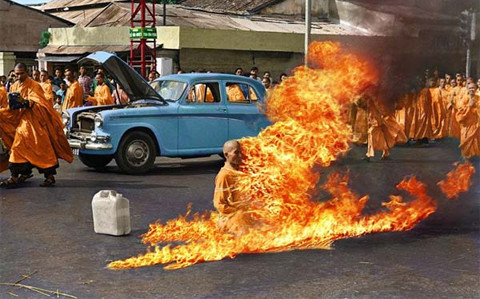
The photo painted with colour by nowdays hi-technology! Source
The author of the photo was Malcolm Browne, the 32-year-old AP reporter, the only Western correspondent to record the self-immolation process of Thich Quang Duc. The picture was awarded the Pulitzer Prize in 1964. Years later, Browne tells the story of how he took that moment. In the morning of June 11th, 1963, monk Thich Quang Duc, two monks accompanied, out of the car at the intersection of two main streets in Saigon. One of the two young monks put the small pillow on! And then he burned himself and returned to the Buddha!
Today I was here seeing his car but his body was no longer here, for a great monk like Thich Quang Duc, I will always feel my great respect and appreciation. He was the second greatest man in the history of Buddhism in Vietnam, just after the Buddhism King Tran Thai Tong in Yen Tu monastery in the north of Vietnam. Although his body is not here, I understood fully his message as for him, the body is nothing, his soul has come back to stand beside the Buddha. Thank you a lot, Thich Quang Duc!
Photo gallery
Content available in other languages
Want to have your own Erasmus blog?
If you are experiencing living abroad, you're an avid traveller or want to promote the city where you live... create your own blog and share your adventures!
I want to create my Erasmus blog! →






















Comments (0 comments)